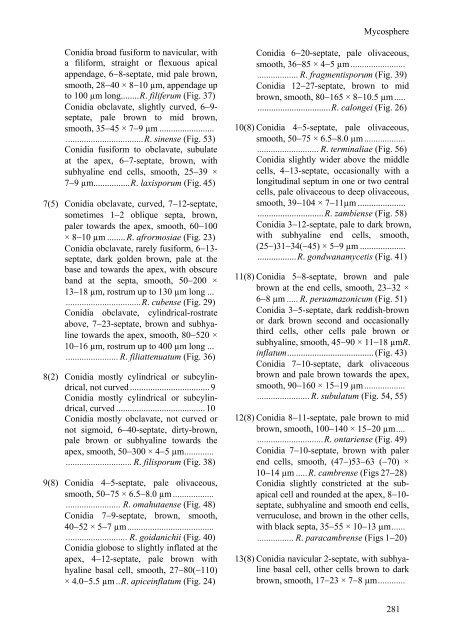A new species and re-disposed taxa in Repetophragma - CBS
A new species and re-disposed taxa in Repetophragma - CBS
A new species and re-disposed taxa in Repetophragma - CBS
You also want an ePaper? Increase the reach of your titles
YUMPU automatically turns print PDFs into web optimized ePapers that Google loves.
Mycosphe<strong>re</strong>Conidia broad fusiform to navicular, witha filiform, straight or flexuous apicalappendage, 6−8-septate, mid pale brown,smooth, 28−40 × 8−10 µm, appendage upto 100 µm long........R. filiferum (Fig. 37)Conidia obclavate, slightly curved, 6−9-septate, pale brown to mid brown,smooth, 35−45 × 7−9 µm ..........................................................R. s<strong>in</strong>ense (Fig. 53)Conidia fusiform to obclavate, subulateat the apex, 6−7-septate, brown, withsubhyal<strong>in</strong>e end cells, smooth, 25−39 ×7−9 µm................R. laxisporum (Fig. 45)7(5) Conidia obclavate, curved, 7−12-septate,sometimes 1−2 oblique septa, brown,paler towards the apex, smooth, 60−100× 8−10 µm ........ R. afrormosiae (Fig. 23)Conidia obclavate, ra<strong>re</strong>ly fusiform, 6−13-septate, dark golden brown, pale at thebase <strong>and</strong> towards the apex, with obscu<strong>re</strong>b<strong>and</strong> at the septa, smooth, 50−200 ×13−18 µm, rostrum up to 130 µm long ....................................R. cubense (Fig. 29)Conidia obclavate, cyl<strong>in</strong>drical-rostrateabove, 7−23-septate, brown <strong>and</strong> subhyal<strong>in</strong>etowards the apex, smooth, 80−520 ×10−16 µm, rostrum up to 400 µm long .......................... R. filiattenuatum (Fig. 36)8(2) Conidia mostly cyl<strong>in</strong>drical or subcyl<strong>in</strong>drical,not curved ...................................9Conidia mostly cyl<strong>in</strong>drical or subcyl<strong>in</strong>drical,curved .......................................10Conidia mostly obclavate, not curved ornot sigmoid, 6−40-septate, dirty-brown,pale brown or subhyal<strong>in</strong>e towards theapex, smooth, 50−300 × 4−5 µm.......................................... R. filisporum (Fig. 38)9(8) Conidia 4−5-septate, pale olivaceous,smooth, 50−75 × 6.5−8.0 µm .......................................... R. omahutaense (Fig. 48)Conidia 7−9-septate, brown, smooth,40−52 × 5−7 µm ................................................................. R. goidanichii (Fig. 40)Conidia globose to slightly <strong>in</strong>flated at theapex, 4−12-septate, pale brown withhyal<strong>in</strong>e basal cell, smooth, 27−80(−110)× 4.0−5.5 µm ..R. apice<strong>in</strong>flatum (Fig. 24)Conidia 6−20-septate, pale olivaceous,smooth, 36−85 × 4−5 µm .......................................... R. fragmentisporum (Fig. 39)Conidia 12−27-septate, brown to midbrown, smooth, 80−165 × 8−10.5 µm.....................................R. calongei (Fig. 26)10(8) Conidia 4−5-septate, pale olivaceous,smooth, 50−75 × 6.5−8.0 µm ............................................. R. term<strong>in</strong>aliae (Fig. 56)Conidia slightly wider above the middlecells, 4−13-septate, occasionally with alongitud<strong>in</strong>al septum <strong>in</strong> one or two centralcells, pale olivaceous to deep olivaceous,smooth, 39−104 × 7−11µm ..................................................R. zambiense (Fig. 58)Conidia 3−12-septate, pale to dark brown,with subhyal<strong>in</strong>e end cells, smooth,(25−)31−34(−45) × 5−9 µm .....................................R. gondwanamycetis (Fig. 41)11(8) Conidia 5−8-septate, brown <strong>and</strong> palebrown at the end cells, smooth, 23−32 ×6−8 µm ..... R. peruamazonicum (Fig. 51)Conidia 3−5-septate, dark <strong>re</strong>ddish-brownor dark brown second <strong>and</strong> occasionallythird cells, other cells pale brown orsubhyal<strong>in</strong>e, smooth, 45−90 × 11−18 µmR.<strong>in</strong>flatum...................................... (Fig. 43)Conidia 7−10-septate, dark olivaceousbrown <strong>and</strong> pale brown towards the apex,smooth, 90−160 × 15−19 µm .........................................R. subulatum (Fig. 54, 55)12(8) Conidia 8−11-septate, pale brown to midbrown, smooth, 100−140 × 15−20 µm.................................R. ontariense (Fig. 49)Conidia 7−10-septate, brown with pale<strong>re</strong>nd cells, smooth, (47−)53−63 (−70) ×10−14 µm .....R. camb<strong>re</strong>nse (Figs 27−28)Conidia slightly constricted at the subapicalcell <strong>and</strong> rounded at the apex, 8−10-septate, subhyal<strong>in</strong>e <strong>and</strong> smooth end cells,verruculose, <strong>and</strong> brown <strong>in</strong> the other cells,with black septa, 35−55 × 10−13 µm...................... R. paracamb<strong>re</strong>nse (Figs 1−20)13(8) Conidia navicular 2-septate, with subhyal<strong>in</strong>ebasal cell, other cells brown to darkbrown, smooth, 17−23 × 7−8 µm............281
















